A MAP
A drawing made to show a room, or a house; or the school-yard, or even a vilage, is caled a plan.
Drawings which represent land and water are caled
maps. You may learn from maps where the countries,
and mountains, and rivers, and cities are that you have
seen. It also shows how far places are from one another.
Here is a map showing mountains and rivers. The many
short lines facing each other represent mountains. To
show the very high part of the mountains, the lines are
drawn close to each other, making that part of the map
look dark. The line winding about, like the stream itself,
represents a river. The line, as you see, is made thicker
and thicker toward its mouth. From this you may know
that the river itself becomes broader and broader as it flows toward the sea.
But you must not think that the crooked line on the map is a river, or the lines which face each other are mountains. If you do, you wil learn very little of geography. When you look at these lines, you must think of the real things which they stand for--the lofty mountains, with their covering of forests, and with long, narrow valeys between them; the winding, gently flowing river, bearing boats upon its waters.
LESSON XXV.
FORMS OF LAND AND WATER.
You al know what a pond is. Is there a pond near where you live? Did you ever fish in it?
Did you ever walk round it?
When a stream, on its way to the ocean, flows into a basin or holow in the land, the water spreads out and fils it. A holow in the land filed with water is caled a lake, or, if it be quite smal, a pond.
www.gutenberg.org/files/12228/12228-h/12228-h.htm
35/73

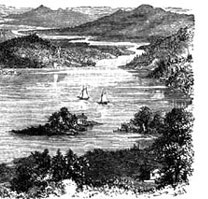
8/10/12
The Project Gutenberg eBook of Home Geography for Primary Grades
What is a lake made of? What is round it? Suppose some one who never saw a lake were to
ask you what a lake is, what would you say?
What do we find in lakes? Would you not like to sail on a lake?
In the holows among mountains are great numbers of beautiful lakes. In their clear waters
may be seen the mountains, the forests, and the sky, as in a looking-glass. At night the moon and stars may be seen below you as plainly as above.
Here is a picture of a pretty lake in a valey.
You see a river flowing from the hils
beyond. Into what is it flowing? The river
that lets the water into the lake is caled an
inlet.
You see another river that lets the water out
of the lake. This river we cal the outlet of
the lake.
Make a lake on your molding-board, or in
the sand near your home. Represent its inlet
and outlet.
Out in the lake is a little piece of land round which the waters play. We could
not go to this land without crossing the water; the water is on al sides of it.
Such a little piece of land is caled an island.
Did you ever read the story of Robinson Crusoe? You wil remember that he went up a hil in
search of water. When he got to the top of the hil, he saw that he was on an island. How did he know?
Have you ever seen an island? What island was it? Could you sail round it? What was on
every side of it? What grew on it? What is an island?
If there is a brook or lake near your home, how can you make an island?
Opposite is a picture of a river and a lake. Make a map of the same river and lake on your slate. Notice how the coast or shore of the lake bends in and out.
Write the following:
A lake is water surrounded by land.
The land near the water of a lake is caled its shore.
An island is a little piece of land surrounded by water.
www.gutenberg.org/files/12228/12228-h/12228-h.htm
36/73
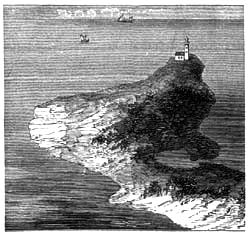

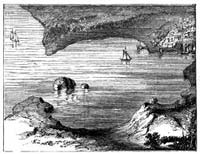
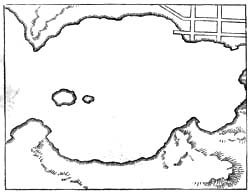
8/10/12
The Project Gutenberg eBook of Home Geography for Primary Grades
LESSON XXVI.
MORE ABOUT FORMS OF LAND AND WATER.
MAP O F A PENINSULA.
In the picture we see a narrow strip of land
which extends far out into the water. You wil
PICTURE O F A PENINSULA.
notice that the land has water al round; except
at one place.
What is the name for land that has water on al sides but one? What is a peninsula? An island, as we have learned, is a piece of land with water al round it. Now, sometimes we see a piece of land that has water nearly al round it. This form of land is caled a peninsula. The word peninsula means almost an island.
How would you change this peninsula to an island? What is the difference between a
peninsula and an island?
The narrow neck which joins the peninsula to other land--just as the neck joins the head to the body-is caled an isthmus, which means neck.
Here is
another
picture
which I
wish
you to
look at.
You see
where
PICTURE O F A BAY.
the
www.gutenberg.org/files/12228/12228-h/12228-h.htm
37/73

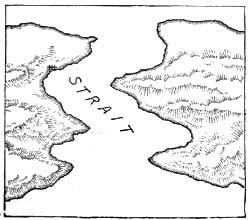
8/10/12
The Project Gutenberg eBook of Home Geography for Primary Grades
MAP O F A BAY.
shore bends like a bow; and the water runs a
little way into the land.
Can you think of anything else that is bent like this? Yes-a bay-window.
Now, when I tel yon that bay means the same as bow, you can almost guess the name for
this bend in the land. It is caled a bay. You wil easily remember that little word.
A wide opening or bend in the land, into which the water flows, is usualy caled a bay.
Sometimes, when the opening in the bend is long and narrow, it is caled a gulf.
On the
next
page is
shown a
narrow
strip of
water
joining
two
larger
bodies
PICTURE O F A STRAIT.
of
water.
The name given to this narrow passage is
MAP O F A STRAIT.
strait, a word meaning narrow.
As an isthmus connects two bodies of land, so a strait connects two bodies of water.
After a rain make little lakes, rivers, bays, etc. Perhaps you may find some already made.
See whether you can find in the magazines and books at home pictures of gulfs, bays,
peninsulas, etc.
Write the following: A peninsula is land almost surrounded by water.
An isthmus is a neck of land joining two larger bodies of land.
A gulf or bay is a portion of some large body of water extending into the land.
A strait is a narrow passage of water that joins two larger bodies of water.
www.gutenberg.org/files/12228/12228-h/12228-h.htm
38/73
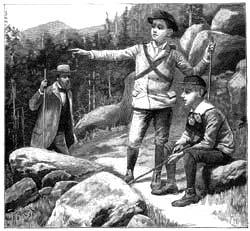
8/10/12
The Project Gutenberg eBook of Home Geography for Primary Grades
LESSON XXVII.
A TRIP TO THE HIGHLANDS.
Uncle Tom had been teling Fred and me about many strange places he had seen. Last of al,
he told us about some high mountains he had climbed. We wanted to climb one very much.
So father said he would go with us up a high hil not far from the city.
Mother did not need to cal us in the morning, for we woke up very early. The sky in the east was bright, and we knew that soon we should see the sun. We wanted to start at once, but
mother said it would be better to have breakfast first.
We put on thick shoes that the stones would not easily cut. Father gave each of us a stout stick to help us climb. Fred had a knapsack, in which mother put some bread, cold meat,
crackers, and a cup to drink from. In one corner we put some towels.
We were soon outside the city, walking along the road. We passed a vilage, and went
through fields and woods. By and by we could see the land before us rising higher and higher.
We saw no longer such beautiful farms and gardens as we had passed.
In a little while we reached the foot of the hil
and began to ascend. As we went up the
slope, we came to steep, rugged places that
were hard to climb, where we needed our
sticks. The trees were smaler, and there were
many bushes. There were large rocks, too, in
the sides of the hil. At the foot, the weather
was quite warm, but it grew cooler and cooler
the higher we went.
"On the summit at last!" cried Fred, as we
reached the top.
AS WE WENT UP THE SLO PE.
From where we stood, we could see the city
with its little straight streets, that look so
wide when we walk on them. We could
see the house-tops, too, and the church
steeples. Then father showed us the
vilage we passed; and the woods we
went through. But the trees looked like
bushes, and some men at the foot of the
hil looked no larger than the baby.
www.gutenberg.org/files/12228/12228-h/12228-h.htm
39/73
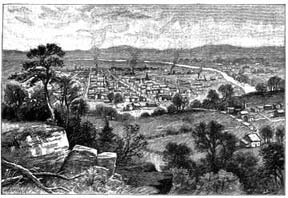
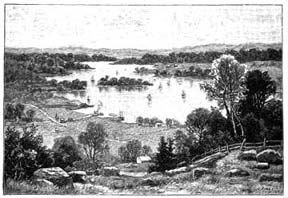
8/10/12
The Project Gutenberg eBook of Home Geography for Primary Grades
Down the mountain, a little way, we
found a spring where the water was
clear and cool. Here we sat down on a
rock, and ate the lunch we had brought.
While we rested, we watched the little
ril that flowed from the spring--
"Blue in the shadow,
Silver in the sun."
Down the hil, it was larger, and we saw
WE CO ULD SEE THE CITY WITH ITS LITTLE
other rils flowing into it. When it
STRAIGHT STREETS.
reached the valey, it was much larger;
and farther down, father said, boats could sail on it.
Before us, in the valey, lay a large sheet
of stil water.
"Oh, how pretty!" exclaimed I.
"Yes, that is a lake," said father. "How
beautiful it looks as the sunlight plays on
its smooth surface! It reflects in its clear
water the sky and the trees around it."
"I can see an island in the lake," said
Fred. "Vessels are sailing al round it."
"Are al islands smal, like that?" he
asked.
"Oh, no!" said father. "Some islands are
hundreds of miles round, and have many
IN THE VALLEY LAY A LARGE SHEET O F STILL
people living upon them."
WATER.
Fred then pointed to a piece of land extending out into the water, and asked whether that, too, was an island.
"No," replied father, "that is a peninsula. It is land almost surrounded by water. And the narrow neck which joins the peninsula to the mainland is caled an isthmus.
"You see the bend in the land, with the water from the lake running in?" asked father.
"Yes," said Fred.
"That is caled a bay. Around every ocean, which is a much larger body of water, there are many such bays.
"The narrow strip of water, which a boat is just entering, is caled a strait. The strait separates www.gutenberg.org/files/12228/12228-h/12228-h.htm
40/73
8/10/12
The Project Gutenberg eBook of Home Geography for Primary Grades
the island from the mainland."
Stretching far away to the east was flat, level land, which father caled a plain. Scattered here and there were many farmhouses and quiet vilages. Little bright, sparkling streams wound
their way like silver threads through the green grass of the meadows. It was a lovely scene indeed!
The sun was already low in the west as we made ready to return. As it set--
A wonderful glory of color,
A splendor of shifting light--
Orange and scarlet and purple
Flamed in the sky so bright.
LESSON XXVIII.
SPRING.
Drops of rain and bits of
Violets, in blue and
sunshine
purple,
Faling here and
By the twinkling water
gleaming there,
clear;
Tiny blades of grass
Fair spring beauties, frail
appearing.
and dainty,
Tel of springtime
Tel the story, spring is
bright and fair.
here.
Budding leaves are
Cherry, peach, and
gently swaying,
apple blossoms
Merry glad notes
Scattering fragrance far
sweetly ring;
and wide;
Robins, bluebirds, gayly
Buttercups and pure
singing,
white snowdrops
Tel of happy, pleasant
Tel of gracious, sweet
spring.
springtide.
---Lillian Cox.
www.gutenberg.org/files/12228/12228-h/12228-h.htm
41/73
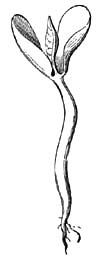
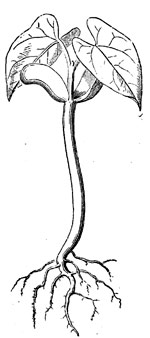
8/10/12
The Project Gutenberg eBook of Home Geography for Primary Grades
LESSON XXIX.
USEFUL VEGETABLES.
In the heart of a seed buried deep, so
deep, A dear little plant lay fast asleep.
"Wake!" said the sunshine, "and creep to
the light."
"Wake!" said the voice of the raindrops
bright.
The little plant heard, and it rose to see
What the wonderful outside world might
be.
What vegetables grow in your
neighborhood?
Of which do we use the roots as food?
Of which the leaves? Of which the seeds?
Of which the stems or stalks?
Which is the most useful garden
vegetable? There is no common garden
vegetable so highly thought of as the
potato. How are potatoes planted?
Answer the questions in writing so as to
A SPRO UT.
make a little composition about
vegetables.
















